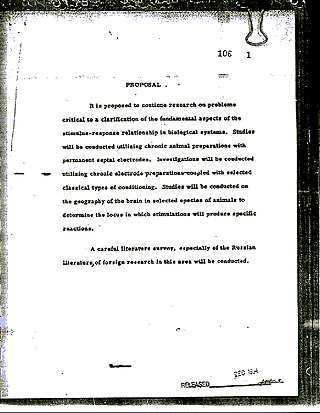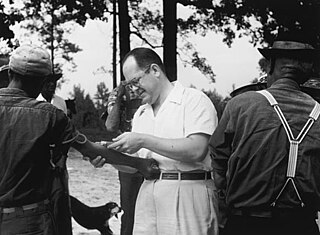Related Research Articles

"Truth serum" is a colloquial name for any of a range of psychoactive drugs used in an effort to obtain information from subjects who are unable or unwilling to provide it otherwise. These include ethanol, scopolamine, 3-quinuclidinyl benzilate, midazolam, flunitrazepam, sodium thiopental, and amobarbital, among others.

Project MKUltra was an illegal human experimentation program designed and undertaken by the U.S. Central Intelligence Agency (CIA), intended to develop procedures and identify drugs that could be used in interrogations to weaken individuals and force confessions through brainwashing and psychological torture. It began in 1953 and was halted in 1973. MKUltra used numerous methods to manipulate its subjects' mental states and brain functions, such as the covert administration of high doses of psychoactive drugs and other chemicals without the subjects' consent, electroshocks, hypnosis, sensory deprivation, isolation, verbal and sexual abuse, and other forms of torture.
The term incapacitating agent is defined by the United States Department of Defense as:

Frank Rudolph Emmanuel Olson was an American bacteriologist, biological warfare scientist, and an employee of the United States Army Biological Warfare Laboratories (USBWL) who worked at Camp Detrick in Maryland. At a meeting in rural Maryland, he was covertly dosed with LSD by his colleague Sidney Gottlieb and, nine days later, plunged to his death from the window of the Hotel Statler in New York. The U.S. government first described his death as a suicide, and then as misadventure, while others allege murder. The Rockefeller Commission report on the CIA in 1975 acknowledged their having conducted covert drug studies on fellow agents. Olson's death is one of the most mysterious outcomes of the CIA mind control project MKUltra.

Sidney Gottlieb was an American chemist and spymaster who headed the Central Intelligence Agency's 1950s and 1960s assassination attempts and mind-control program, known as Project MKUltra.

MKNAOMI is the code name for a joint Department of Defense/CIA research program from the 1950s through to the 1970s. Unclassified information about the MKNAOMI program and the related Special Operations Division is scarce. It is generally reported to be a successor to the MKULTRA project focusing on biological projects including biological warfare agents—specifically, to store materials that could either incapacitate or kill a test subject and to develop devices for the diffusion of such materials.
Project CHATTER was a United States Navy program beginning in the fall of 1947 focusing on the identification and testing of drugs in interrogations and the recruitment of agents. Their search included laboratory experiments on both animal and human subjects. The program operated under the direction of Charles Savage of the Naval Medical Research Institute, Bethesda, Maryland, from 1947 to 1953. The project was geared to identifying agents both synthetic and natural that were effective during interrogation. The project was centered on, but not restricted to, the use of anabasine, scopolamine and mescaline. The program ended shortly after the Korean War in 1953.
The Office of Technical Service is a component of the U.S. Central Intelligence Agency, responsible for supporting CIA's clandestine operations with gadgets, disguises, forgeries, secret writings, and weapons. In the 1950s and early 1960s it also researched, investigated, and experimented with the use of drugs, chemicals, hypnosis, and isolation to extract information during interrogation, as well as to make it easier for American captives to resist interrogation. OTS is part of CIA's Directorate of Science and Technology.

The United States President's Commission on CIA Activities within the United States was ordained by President Gerald Ford in 1975 to investigate the activities of the Central Intelligence Agency and other intelligence agencies within the United States. The Presidential Commission was led by Vice President Nelson Rockefeller, from whom it gained the nickname the Rockefeller Commission.

Project FUBELT is the codename for the secret Central Intelligence Agency operations that were to prevent Salvador Allende's rise to power before his confirmation and to promote a military coup in Chile. This project came after the circumstantial failure of Track I, which involved making president Eduardo Frei Montlava interfere with the 1970 national election in opposition to Allende.
Operation Midnight Climax was an operation carried out by the CIA as a sub-project of Project MKUltra, the mind-control research program that began in the 1950s. It was initially established in 1954 by Sidney Gottlieb and placed under the direction of the Federal Bureau of Narcotics in Boston, Massachusetts with the "Federal Narcotics Agent and CIA consultant" George Hunter White under the pseudonym of Morgan Hall. Dr. Sidney Gottlieb was a chemist who was chief of the Chemical Division of the Technical Services Staff of the CIA. Under the Cold War and fears of the Soviet Union and China, Gottlieb felt inspired to investigate methods of mind control. Gottlieb based his plan for Project MKUltra and Operation Midnight Climax off of interrogation method research under Project Artichoke. Unlike Project Artichoke, Operation Midnight Climax gave Gottlieb permission to test drugs on unknowing citizens, which made way for the legacy of this operation. Hundreds of federal agents, field operatives, and scientists worked on these programs before they were shut down in the 1960s.

The Central Intelligence Agency (CIA) is a civilian foreign intelligence service of the United States federal government, tasked with gathering, processing, and analyzing national security information from around the world.
It has been traditionally believed that any U.S. Central Intelligence Agency activity in Canada would be undertaken with the "general consent" of the Canadian government, and through the 1950s information was freely given to the CIA in return for information from the United States. However, traditionally Canada has refused to voice any anger even when it was clear that the CIA was operating without any authorisation.
Psychochemical warfare — or "drug weapons" — involves the use of psychopharmacological agents with the intention of incapacitating an adversary through the temporary induction of hallucinations or delirium. These agents have generally been considered chemical weapons and, more narrowly, constitute a specific type of incapacitating agent. Although never developed into an effective weapons system, psychochemical warfare theory and research—along with overlapping mind control drug research—was secretly pursued in the mid-20th century by the US military and Central Intelligence Agency (CIA) in the context of the Cold War. These research programs were ended when they came to light and generated controversy in the 1970s. The degree to which the Soviet Union developed or deployed similar agents during the same period remains largely unknown.

Numerous experiments which are performed on human test subjects in the United States are considered unethical, because they are performed without the knowledge or informed consent of the test subjects. Such tests have been performed throughout American history, but some of them are ongoing. The experiments include the exposure of humans to many chemical and biological weapons, human radiation experiments, injections of toxic and radioactive chemicals, surgical experiments, interrogation and torture experiments, tests which involve mind-altering substances, and a wide variety of other experiments. Many of these tests are performed on children, the sick, and mentally disabled individuals, often under the guise of "medical treatment". In many of the studies, a large portion of the subjects were poor, racial minorities, or prisoners.

Acid Dreams: The Complete Social History of LSD: the CIA, the Sixties, and Beyond, originally released as Acid Dreams: The CIA, LSD, and the Sixties Rebellion, is a 1985 book by Martin A. Lee and Bruce Shlain, in which the authors document the 40-year social history of lysergic acid diethylamide (LSD), beginning with its synthesis by Albert Hofmann of Sandoz Pharmaceuticals in 1938. During the Cold War period of the early 1950s, LSD was tested as an experimental truth drug for interrogation by the United States intelligence and military community. Psychiatrists also used it to treat depression and schizophrenia. Under the direction of Sidney Gottlieb, the drug was used by the Central Intelligence Agency (CIA) in cooperation with participating "colleges, universities, research foundations, hospitals, clinics, and penal institutions". LSD was tested on "prisoners, mental patients, volunteers, and unsuspecting human subjects".
The Montreal experiments were a series of experiments, initially aimed to treat schizophrenia by changing memories and erasing the patients' thoughts using Donald Ewen Cameron's method of “psychic driving”, as well as drug-induced sleep, intensive electroconvulsive therapy, sensory deprivation and Thorazine. The experiments were conducted at the Allan Memorial Institute of McGill University between 1957 and 1964 by the Scottish psychiatrist Donald Ewen Cameron and funded by the CIA as part of Project MKUltra, which lasted until 1973 and was only revealed to the public in 1975.

Poisoner in Chief: Sidney Gottlieb and the CIA Search for Mind Control is a 2019 book by The New York Times journalist and historian Stephen Kinzer. The book contains untold stories of a Central Intelligence Agency (CIA) chemist called Sidney Gottlieb, who tried to "find a way to control the human brain". In 1953, CIA director Allen Dulles appointed Gottlieb to "run the covert program".

Paul Francis Gaynor was an American military officer and Central Intelligence Agency operative. He is best known for his involvement in Project MK Ultra, having overseen and directed its predecessor, Project ARTICHOKE. He is a recipient of the Distinguished Service Cross.

MK Ultra is a 2022 American psychological thriller film written and directed by ex-intelligence officer Joseph Sorrentino. Based on a true story about the human experimentation program MKUltra conducted by Central Intelligence Agency (CIA) in the 1960s, the film follows Dr. Ford Strauss, a psychiatrist who gets involved in a government experiment and conspiracy involving the use of psychedelic and other mind-controlling substances. It was released theatrically and on video on demand on October 7, 2022.
References
- Maret, Susan (2018-02-16). "Murky Projects and Uneven Information Policies: A Case Study of the Psychological Strategy Board and CIA". Secrecy and Society. 1 (2). doi: 10.31979/2377-6188.2018.010206 . ISSN 2377-6188.
- Ronson, Jon (2004). The Men Who Stare at Goats . London: Picador. ISBN 0-330-37547-4. OCLC 56653467.